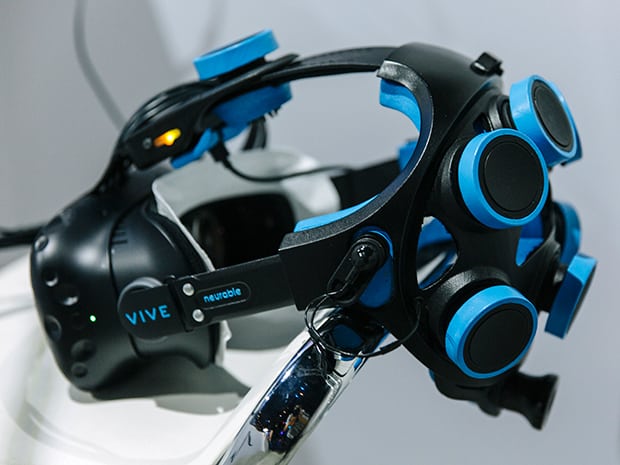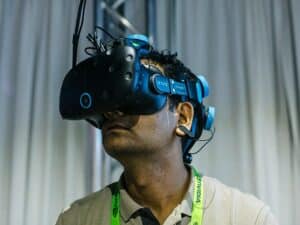There’s fascinating news out of the SIGGRAPH conference this week. The Boston-based start-up, Neurable, unveiled the world’s first mind-controlled VR game.
As you may know, we’ve never been fans of the current interfaces in VR. From hand-controllers (why do I have to hold something in order to pick something up?) to navigation menus (Seriously? You want me to position the floating dot?), current solutions leave much to be desired.
A mind-controlled VR game interface has been something of a Holy Grail in immersive technology. Just the idea that you can make something happen by simply thinking or willing it is tantalizing. Sort of like real life.
But don’t toss out those hand-controllers just yet.
Mind-controlled VR game
Here’s the summary of Neurable’s game – Awakening – from IEEE Spectrum,
The game on display at SIGGRAPH is a collaboration between Neurable and the Madrid-based VR graphics company estudiofuture, and it is meant merely as a demo of Neurable’s tech and its capabilities. It’s played on an HTC Vive headset by swapping out the Vive’s standard elastic strap and putting in Neurable’s upgraded strap, which is studded with seven electrodes.
It involves much more than putting on a device like InteraXon’s MUSE meditative headband to relax. We’re fond of MUSE as a brain-wave wearable, though it struggles to compete against the chaotic environment of Manhattan.
Neurable approach to brain-computer interfaces (BCIs) is based on research for controlling robotic limbs. They’re not reading EEG brainwave patterns. Instead,
Neurable’s software registers event-related potentials, more specific signals that occur when the brain responds to a stimuli, which allows for an intention-based interaction method.
That means the electrodes on the headband have to be larger and positioned carefully. It’s much more complicated than a consumer relaxation wearable. But it also means you can trigger actions instead of a meditative experience.

BCI: Skepticism amidst the Excitement
The jury is still out on how accurate this can be as a VR interface. BCI projects in the past have a track record of disappointment. Though we could add that VR also had a poor track record until recently.
As Futurism noted,
Some researchers have expressed skepticism that this technology can ever be commercially viable; Jack Gallant, head of UC Berkeley’s Neuroscience Lab, told the Guardian it was “conceptually trivial but just about impossible to do” due to the difficulty of decoding brain signals through the thick human skull.
Is this the moment when BCI succeeds? In an interview in Spectrum, Neurable CEO Ramses Alcaide argues,
A lot of people come in highly skeptical, because BCI has been a disappointment so many times before . . . But as soon as they grab an object, there’s a smile that comes over their faces. You can see the satisfaction that it really works.
. . .We can consistently provide quality that is leaps beyond what people expect. In time, new BCI systems are going to step out of the crowd of disappointments that currently exists.
Neurable doesn’t have the massive funding that companies like Magic Leap attract (though the latter has yet to demo anything). But they’ve pulled in $2 million in seed funding and more this summer.
They have big plans to capitalize on location-based entertainment use of the technology. The game may be out in VR arcades by 2018 giving the public its first taste of BCI. Long term, the plan is to develop a next-generation operating system.
According to Ramses Alcaide, form-factor challenges are not an issue and the tech is device agnostic. So yes, Oculus and even HoloLens could be players here.
You may not have telekinetic powers yet, but some day you will. As Alcaide says,
A world without limitations is our core message.
In the meantime, here’s a quick video of a user learning to use Neurable’s system to select objects.
Emory Craig is a writer, speaker, and consultant specializing in virtual reality (VR) and artificial intelligence (AI) with a rich background in art, new media, and higher education. A sought-after speaker at international conferences, he shares his unique insights on innovation and collaborates with universities, nonprofits, businesses, and international organizations to develop transformative initiatives in XR, AI, and digital ethics. Passionate about harnessing the potential of cutting-edge technologies, he explores the ethical ramifications of blending the real with the virtual, sparking meaningful conversations about the future of human experience in an increasingly interconnected world.

